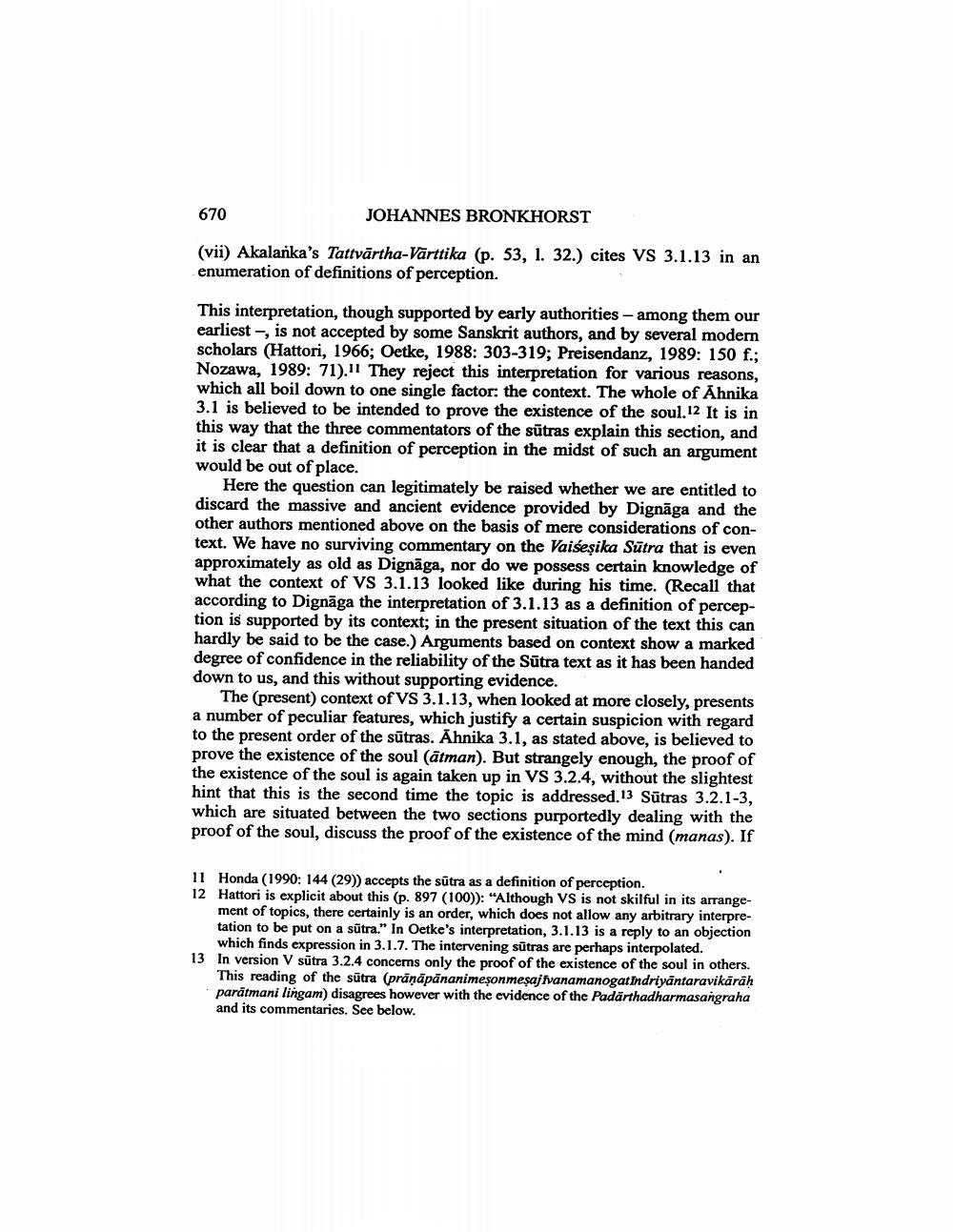Book Title: Once Again Vaisesika Sutra 3 1 13 Author(s): Johannes Bronkhorst Publisher: Johannes Bronkhorst View full book textPage 6
________________ 670 JOHANNES BRONKHORST (vii) Akalanka's Tattvārtha-Vārttika (p. 53, 1. 32.) cites VS 3.1.13 in an enumeration of definitions of perception. This interpretation, though supported by early authorities - among them our earliest, is not accepted by some Sanskrit authors, and by several modern scholars (Hattori, 1966; Oetke, 1988: 303-319; Preisendanz, 1989: 150 f.; Nozawa, 1989: 71).11 They reject this interpretation for various reasons, which all boil down to one single factor: the context. The whole of Āhnika 3.1 is believed to be intended to prove the existence of the soul. 12 It is in this way that the three commentators of the sūtras explain this section, and it is clear that a definition of perception in the midst of such an argument would be out of place. Here the question can legitimately be raised whether we are entitled to discard the massive and ancient evidence provided by Dignāga and the other authors mentioned above on the basis of mere considerations of context. We have no surviving commentary on the Vaiseșika Sūtra that is even approximately as old as Dignāga, nor do we possess certain knowledge of what the context of VS 3.1.13 looked like during his time. (Recall that according to Dignāga the interpretation of 3.1.13 as a definition of perception is supported by its context; in the present situation of the text this can hardly be said to be the case.) Arguments based on context show a marked degree of confidence in the reliability of the Sūtra text as it has been handed down to us, and this without supporting evidence. The (present) context of VS 3.1.13, when looked at more closely, presents a number of peculiar features, which justify a certain suspicion with regard to the present order of the sūtras. Āhnika 3.1, as stated above, is believed to prove the existence of the soul (ātman). But strangely enough, the proof of the existence of the soul is again taken up in VS 3.2.4, without the slightest hint that this is the second time the topic is addressed. 13 Sūtras 3.2.1-3, which are situated between the two sections purportedly dealing with the proof of the soul, discuss the proof of the existence of the mind (manas). If 11 Honda (1990: 144 (29)) accepts the sutra as a definition of perception. 12 Hattori is explicit about this (p. 897 (100)): "Although VS is not skilful in its arrange ment of topics, there certainly is an order, which does not allow any arbitrary interpretation to be put on a sūtra." In Oetke's interpretation, 3.1.13 is a reply to an objection which finds expression in 3.1.7. The intervening sütras are perhaps interpolated. 13 In version V sūtra 3.2.4 concerns only the proof of the existence of the soul in others. This reading of the sutra (prānāpānanimeson mesaj fvanamanogat indriyantaravikārah parātmani lingam) disagrees however with the evidence of the Padarthadharmasangraha and its commentaries. See below.Page Navigation
1 ... 4 5 6 7 8 9 10 11 12 13 14 15 16 17
